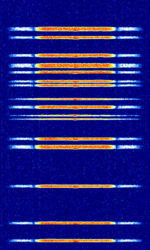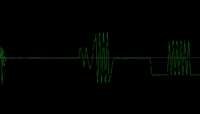Schneider Trio E-Series Modem
 | |
|---|---|
| Frequencies | 370 MHz,518 MHz |
| Frequency Range | 370 MHz - 518 MHz |
| Mode | USB |
| Modulation | GMSK,FSK |
| ACF | — |
| Emission Designator | — |
| Bandwidth | 12.5 kHz,25 kHz |
| Location | Worldwide |
| Short Description | Schneider Trio E-Series Modems are industrial modems used for SCADA, telemetry, and other ASCII-based messaging applications. |
| I/Q Raw Recording | Download file |
| Audio Sample | |
Schneider Trio E-Series Modems are industrial data modems used for SCADA, telemetry, and other ASCII-based messaging applications. These modems were originally developed by Trio Datacom Pty Ltd and sold under their name. In 2011 Trio Datacom, along with Control Microsystems, were acquired by Schneider Electric and were rebranded into Telemetry and Remote SCADA Solutions within Schneider's Industry Business.
Characteristics[edit]
Some general characteristics differ based on region, but the common features include 2GMSK/3GMSK/4GMSK waveform within a 12.5 kHzKiloHertz (kHz) 10^3 Hz or 25 kHzKiloHertz (kHz) 10^3 Hz channel. Within the 25 kHzKiloHertz (kHz) 10^3 Hz based waveform (which describes the given audio and IQQuadrature signals form the basis of complex RF signal modulation and demodulation, both in hardware and in software, as well as in complex signal analysis. sample), a tone spacing of 10 kHzKiloHertz (kHz) 10^3 Hz was observed. The symbol rate is presumed to be 9600 sps.
In each data frame sent, a center tone preamble with some sync symbols seem to be transmitted with ~5.2 msmilliseconds (.001 of a second) duration. The data payload itself is variable rate, depending on size of payload.
- In Australia (ACMA), the regulatory modes of operation are 4800/9600 bpsBits per second (bps) @ 12.5 kHzKiloHertz (kHz) 10^3 Hz channel, or 9600/19200 bpsBits per second (bps) @ 25 kHzKiloHertz (kHz) 10^3 Hz channel.
- In the United States (FCC), the regulatory modes of operation are 9600/19200 bpsBits per second (bps) @ 12.5 kHzKiloHertz (kHz) 10^3 Hz channel, or 19200 bpsBits per second (bps) @ 25 kHzKiloHertz (kHz) 10^3 Hz channel.
- In Europe (ETSIEuropean Telecommunications Standards Institute. An independent, not-for-profit, standardization organization in the telecommunications industry in Europe, developing global telecommunications standards.), the regulatory mode of operation is 4800/9600 bpsBits per second (bps) @ 12.5 kHzKiloHertz (kHz) 10^3 Hz channel.
An additional mode that was added around 2005 was support for Bell 202 AFSKAudio Frequency-Shift Keying.
Samples[edit]
USBUpper Side Band Modulation (Radio, referring to reception and modulation mode)Universal Serial Bus (Computer, referring to USB Ports and cables) Demod:
Additional Links[edit]
- Schneider Electric Acquisition of Trio Datacom and Control Microsystems 2011
- Trio Modem User Manual
- FCC Listing NI8EB450-XXF01
